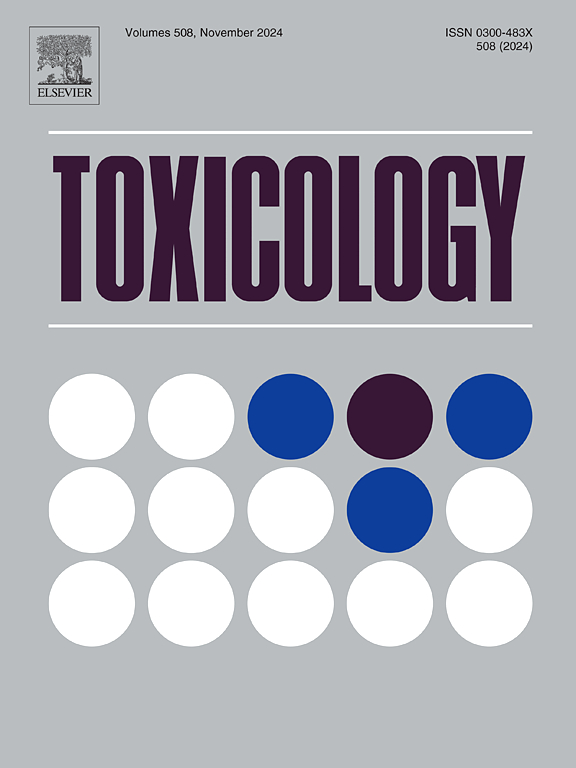污染物对HepaRG和RPTEC/TERT1细胞的短期器官毒性分析。
IF 4.8
3区 医学
Q1 PHARMACOLOGY & PHARMACY
引用次数: 0
摘要
新方法方法(NAMs),包括细胞培养和多层次组学分析,是动物试验的有希望的替代方法。要用于风险评估目的,它们必须适用于不同的物质类别。一类重要的物质是食品污染物,包括合成化学品,如全氟辛烷磺酸(PFOS)和全氟辛酸(PFOA),以及天然化合物,如真菌毒素和吡咯利西啶生物碱。我们测试了五种已知的影响肝脏和/或肾脏的污染物——全氟辛烷磺酸、全氟辛烷磺酸、黄曲霉毒素B1 (AB1)、lasiocarpine (Las)和氯化镉——使用HepaRG和RPTEC/TERT1细胞,在非细胞毒性浓度下测试36和72小时。我们基于nama的测试方案包括细胞功能的标记蛋白分析和靶向转录组学,然后是生物信息学途径分析。观察到的效果与体内建立的结果进行了比较。蛋白分析显示HepaRG细胞中有多种受影响的途径,而在RPTEC/TERT1细胞中的影响一般较小。在HepaRG细胞中,Las的转录影响最大。本研究证明了该测试方案在不同物质中的适用性,揭示了HepaRG和RPTEC/TERT1细胞系之间的显著差异。RPTEC/TERT1细胞虽然表达肾脏特异性CYP酶,但不太适合检测Las和AB1等需要肝脏代谢激活的物质的作用。我们的数据支持特异性通路毒性的概念,通过通路分析可以根据机制而不是靶器官来预测作用。采用多种组学技术提供了对各种复合效应的全面见解,包括脂肪变性、活性氧产生和DNA损伤,突出了扩展组学方法在推进毒理学评估方面的潜力。本文章由计算机程序翻译,如有差异,请以英文原文为准。
NAM-based analysis of contaminant short-term organ toxicity in HepaRG and RPTEC/TERT1 cells
New Approach Methodologies (NAMs), including cell culture and multi-level omics analyses, are promising alternatives to animal testing. To become useable for risk assessment purposes, they have to be applicable for different substance groups. One important group of substances is food contaminants, including synthetic chemicals, such as perfluorooctanesulfonic acid (PFOS) and perfluorooctanoic acid (PFOA), and natural compounds, such as mycotoxins and pyrrolizidine alkaloids. We tested five known contaminants affecting the liver and/or the kidney – PFOS, PFOA, Aflatoxin B1 (AB1), lasiocarpine (Las), and cadmium chloride – using HepaRG and RPTEC/TERT1 cells at non-cytotoxic concentrations for 36 and 72 h. Our NAM-based testing protocol included marker protein analysis for cellular functions and targeted transcriptomics followed by bioinformatics pathway analysis. The effects observed were compared with established in vivo results. Protein analysis indicated various affected pathways in HepaRG cells, with generally fewer effects in RPTEC/TERT1 cells. The strongest transcriptional impact was noted for Las in HepaRG cells. This study demonstrated the test protocol's applicability across different substances, revealing significant differences between HepaRG and RPTEC/TERT1 cell lines. RPTEC/TERT1 cells, while expressing renal-specific CYP enzymes, were less suitable for detecting effects of substances requiring hepatic metabolic activation, like Las and AB1. Our data supports the concept of specific pathway toxicity, with pathway analysis enabling the prediction of effects based on mechanism rather than target organ. Employing multiple omics techniques provided comprehensive insights into various compound effects, including steatosis, reactive oxygen species production and DNA damage, highlighting the potential of an extended omics approach for advancing toxicological assessments.
求助全文
通过发布文献求助,成功后即可免费获取论文全文。
去求助
来源期刊

Toxicology
医学-毒理学
CiteScore
7.80
自引率
4.40%
发文量
222
审稿时长
23 days
期刊介绍:
Toxicology is an international, peer-reviewed journal that publishes only the highest quality original scientific research and critical reviews describing hypothesis-based investigations into mechanisms of toxicity associated with exposures to xenobiotic chemicals, particularly as it relates to human health. In this respect "mechanisms" is defined on both the macro (e.g. physiological, biological, kinetic, species, sex, etc.) and molecular (genomic, transcriptomic, metabolic, etc.) scale. Emphasis is placed on findings that identify novel hazards and that can be extrapolated to exposures and mechanisms that are relevant to estimating human risk. Toxicology also publishes brief communications, personal commentaries and opinion articles, as well as concise expert reviews on contemporary topics. All research and review articles published in Toxicology are subject to rigorous peer review. Authors are asked to contact the Editor-in-Chief prior to submitting review articles or commentaries for consideration for publication in Toxicology.
 求助内容:
求助内容: 应助结果提醒方式:
应助结果提醒方式:


